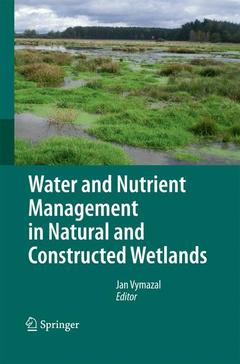Description
Water and Nutrient Management in Natural and Constructed Wetlands, 2011
Coordinator: Vymazal Jan
Language: English
Subject for Water and Nutrient Management in Natural and Constructed...:
Water and Nutrient Management in Natural and Constructed Wetlands
Publication date: 11-2014
330 p. · 15.5x23.5 cm · Paperback
Publication date: 11-2014
330 p. · 15.5x23.5 cm · Paperback
Water and Nutrient Management in Natural and Constructed Wetlands
Publication date: 09-2010
330 p. · 15.5x23.5 cm · Hardback
Publication date: 09-2010
330 p. · 15.5x23.5 cm · Hardback
Description
/li>Contents
/li>Comment
/li>
Natural and constructed wetlands play a very important role within the landscape and their ecological services are highly valuable. Water management, including flood water retention, biomass production, carbon sequestration, wastewater treatment and as a biodiversity source are among the most important ecological services of wetlands. In order to provide these services, wetlands need to be properly evaluated, protected and maintained. This book provides results of the latest research in wetland science around the world. Chapters deal with such topics as the use of constructed wetlands for treatment of various types of wastewater, use of constructed wetlands in agroforestry, wetland hydrology and evapotranspiration, the effect of wetlands on landscape temperature, and chemical properties of wetland soils.
From the Table of Contents: Application of Constructed Wetlands in Recycling, Agriculture and Agroforestry:Water Management for Changing Flow Regimes.- Properties of Biosolids from Sludge Treatment Wetlands for Land Application.- Process Based Models for Subsurface Flow Constructed Wetlands.- Application of Vertical Flow Constructed Wetlands for Highly Contaminated Wastewater Treatment: Preliminary Results.- Comparison of Performance, Ageing and Eco Balance Data from Four Types of Constructed Wetlands Treating Raw Sewage ... Factors Affecting Metal Mobilisation During Oxidation of Sulphidic, Sandy Wetland Substrates.- The Presence of Mycorrhiza in Different Habitats of an Intermittent Aquatic Ecosystem.- Comparison of Reflected Solar Radiation, Air Temperature and Relative Air Humidity in Different Ecosystems: from Fishponds and Wet Meadows to Concrete Surface.
Brings together state-of-the-art knowledge on the uses of wetlands Written by international authors Covers both constructed and natural wetlands Includes case studies
© 2024 LAVOISIER S.A.S.
These books may interest you

The Role of Natural and Constructed Wetlands in Nutrient Cycling and Retention on the Landscape 105.49 €



